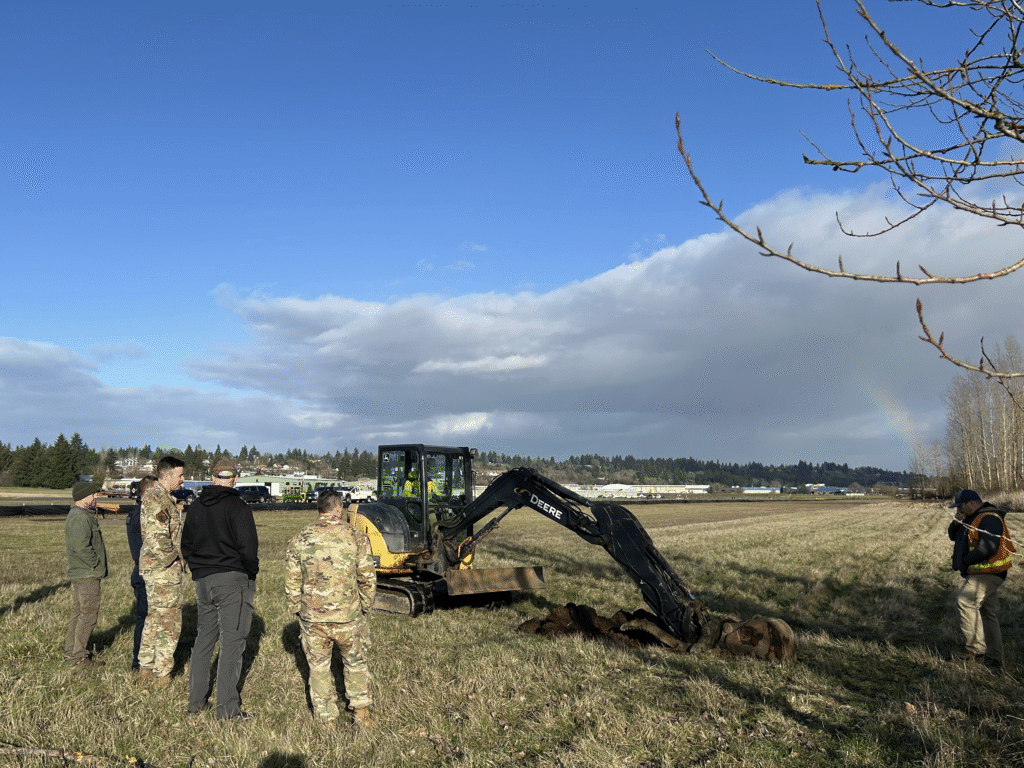What began as a routine construction project quickly turned into a unique and memorable experience for our team at Century West.
On February 24, 2025, Century West began work at Pearson Field in Vancouver, Washington. The site is jointly managed by the City of Vancouver and the National Park Service and carries deep historical significance due to its military use during both World Wars.
By the second day on site, while plowing a narrow 6-inch trench, the construction crew uncovered what appeared to be a rusted iron cylinder. Our on-site archaeologist immediately halted activity and called in additional support. Once the item was identified as a potential World War I-era unexploded ordnance (UXO), Century West quickly began notifying the appropriate agencies to ensure safety and compliance.

From there, the situation escalated quickly and carefully. We coordinated first with the National Park Service, who then contacted the Vancouver Police Department. Because the object appeared to be military-grade and beyond local jurisdiction, the Portland Police bomb squad was consulted but ultimately deferred to the military. The Oregon Air National Guard, based closer than their Washington counterparts, received permission to respond. Their team X-rayed the object and confirmed it did not contain liquid, which helped rule out one of the more dangerous scenarios. However, the scan could not determine if it was a training device or a live explosive.
With safety as the top priority, the decision was made to perform a controlled on-site detonation. The construction team supported the effort by excavating a secure blast pit, and the Oregon Air National Guard performed the detonation using C4. The process was executed smoothly and safely, with only a muted boom marking the event.

The following morning, as work resumed, two more UXOs were discovered. One was identified by the archaeologist and the other by a member of the construction crew. In total, three WWI-era Stokes mortars were found in a relatively small area. According to the National Guard, at least one of them was “likely not for training purposes,” suggesting it may have been a live explosive.
In response to the multiple findings, Century West worked with the City, the National Park Service, and military officials to pause the project while a full UXO survey was conducted. No additional explosives were found, and the project resumed shortly thereafter.
“This was definitely one of the more unusual starts to a project I’ve experienced,” said Lauryn Ryan, Project Engineer at Century West. “But I was proud of how quickly everyone responded and how smoothly things were handled. We had a solid protocol by Day 3.”

A Lesson in Coordination and Preparedness
This experience reinforced the value of flexibility, strong communication, and inter-agency cooperation when working on historically sensitive sites. Some key lessons for our team included:
- Stay adaptable. Field conditions can change quickly. Having a plan is essential, but the ability to adjust that plan is just as important.
- Know your partners. Coordinating across municipal, state, and federal agencies requires clear communication and trust.
- Prioritize safety. Our team remained calm, coordinated, and focused at every step, reflecting the professionalism of everyone involved.
We are proud of how our team responded to this unique challenge and grateful to our agency partners for their expertise and support. It is not every day you unearth a piece of history. When you do, preparation and teamwork make all the difference.
